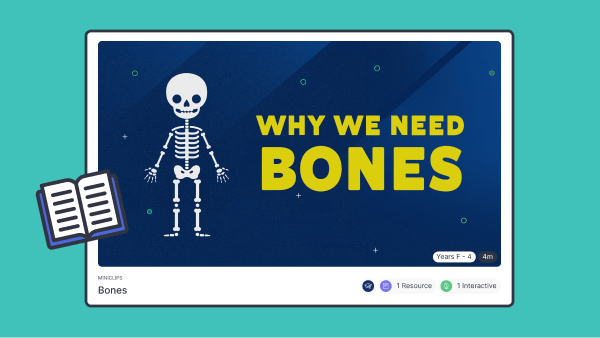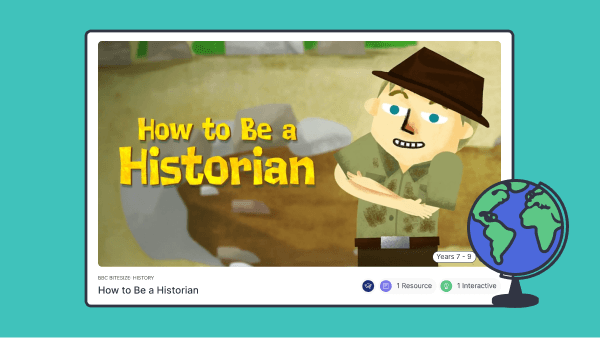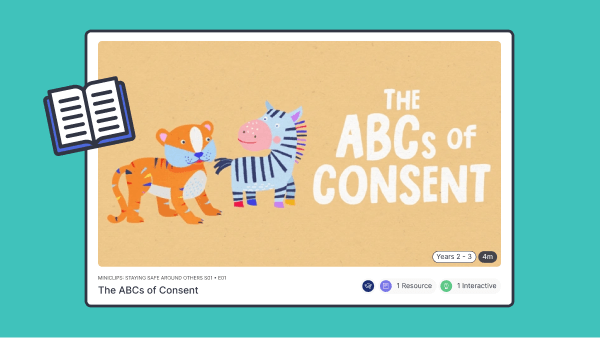Navigating the Changes to the NSW Primary Curriculum With ClickView Topics
NSW K-6 Science, HSIE & PDHPE Curriculum – What’s New?
How are you feeling about the changes to the NSW K-6 curriculum? Excited to explore fresh content? A little overwhelmed by the thought of adjusting your lesson plans? Or maybe a mix of both? With new PDHPE, Science and Technology, and HSIE syllabuses set to roll out in 2027, now’s the time to start familiarising yourself with what’s coming.
As a former primary teacher, I know how challenging curriculum changes can be—not just understanding what’s new, but figuring out how to integrate it into your teaching in a way that works for you and your students. At ClickView we’re committed to helping primary teachers navigate these changes, making the transition as smooth as possible.
While how you teach remains up to you—whether you take an adaptive approach, use Bloom’s taxonomy, embrace PBL, or lean into Inquiry-Based Learning—the content and learning outcomes are set. To support this shift, my team and I have been exploring the updated curriculum and have developed a suite of ClickView Topic pages, series, resources, and videos to complement your planning.
Beyond explicit teaching and knowledge-building, there are three key areas of content that may be new for many teachers: body systems, ancient history, and consent education. If these topics feel unfamiliar, don’t worry—ClickView has curated engaging, curriculum-aligned videos and accompanying resources designed to support concept understanding, vocabulary acquisition, and assessment.
In this blog, I’ll walk you through some of the most useful videos and ClickView Topic pages to help you bring these new curriculum areas to life in the classroom. I hope this saves you time and sparks new ideas for your teaching! I’d love to hear how you’re preparing for these changes.
Skip to sections:
What’s New? Science and Technology
Let’s start with body systems. Older, or shall we say ‘more experienced’, teachers may recall teaching the human body as part of science and technology some years ago. Now, it is back in the New South Wales Science and Technology K-6 Syllabus. Younger learners will explore movement and the senses, while upper primary students will learn how all body systems are integrated.
Check out this ClickView Original clip on muscles—just one of the many videos available on our musculoskeletal system topic page, perfect for middle-primary learners. With dedicated pages on the musculoskeletal, circulatory, respiratory, and digestive systems, teachers can draw on these resources to support their teaching of body systems and their role in the survival of the human body. In addition, our design thinking series is an excellent starting point for introducing students to tasks that involve design challenges in science and technology.
Body Systems Teaching Ideas:
- Design an obstacle course that increases heart rate and engages multiple muscle groups.
- Write a daily exercise and nutrition plan for someone training for an athletics event.
- Create a game for younger learners to teach them about the main body parts essential for survival. Eg; a matching game where physical activities are matched with the body systems they support.
- Write a report about how physical activity can support one or more of the Sustainable Development Goals.

What’s New? HSIE
History and Geography are once again combined under the one umbrella of “HSIE” and a significant change to the New South Wales HSIE syllabus is the addition of ancient history for Stage 1 learners and a stronger emphasis on evaluating sources across all stages of primary school.
The “Research Skills“ series produced by ClickView is ideal for upper primary learners as they develop historical thinking, research, and writing skills.
Brand new ClickView Topics on Ancient & Imperial China, Ancient Greece, Ancient Rome and Ancient Egypt can help teachers boost their confidence in teaching this area of history whilst engaging kids with fascinating facts, images and stories.
Teaching Ideas:
Ancient History offers great opportunities for cross-curricular integration, for example:
- Maths: Integrate timelines and spatial activities, such as designing and constructing a pyramid.
- Geography: Explore the continents of the world, locate ancient landmarks, and study significant sites.
- Aboriginal and Torres Strait Islander Histories and Cultures: Incorporate learning about rock paintings, sacred sites and landmarks, and Dreaming stories into lessons on ancient history.
- English: Study novels based on myths and legends such as Percy Jackson and The Lightning Thief. For more ideas check out the the ClickView page on myths and legends to see how English can support the teaching of ancient beliefs.

What’s New? PDHPE
A significant and important addition to the PDHPE primary syllabus is the teaching of consent. This may seem like a scary concept for teachers to teach to younger learners but never fear ClickView has developed the “Miniclips: Staying Safe Around Others” series specifically to address this area of the syllabus for lower and middle primary learners.
Since consent must be taught with care and consideration for students’ ages, this series ensures that the content is age-appropriate and research-backed. Accompanying resources help assess and reinforce students’ understanding.
Check out the Respectful Relationships page for more videos and resources tailored for upper and lower primary students. As we know, this is a topic that must be addressed not just once but throughout every level of schooling, the resources on this page provide a jumping off point for students as they head towards adolescence.

So don’t be afraid of these new changes but embrace the opportunity to integrate exciting activities, engaging content and fascinating facts with the support of ClickView’s videos. ClickView’s Topic pages can provide inspiration where it is lacking and ideas for extending those students who may be ready for some more challenging work or have a special interest in one of the areas you are teaching. At the same time, don’t forget you can filter by year level to find content suitable for your particular year level. For a more detailed look at the topics that support other areas of the NSW curriculum take a look at the discover pages on ClickView or the table below:
HSIE: History
| Subject and Content | ClickView Topics | Related Outcomes |
| Ancient Greece | Ancient Greece | Stage 1: HS1-HIS-01 describes the ancient past and changes in communication over time, using stories, images, objects and sites as evidence. Stage 3: HS3-CWT-01 creates written texts to communicate ideas and understanding about people, places and events of the past and the present |
| Ancient Rome | Ancient Rome | Stage 1: HS1-HIS-01 describes the ancient past and changes in communication over time, using stories, images, objects and sites as evidence. Stage 3: HS3-CWT-01 creates written texts to communicate ideas and understanding about people, places and events of the past and the present |
| Ancient Egypt | Ancient Egypt | Stage 1: HS1-HIS-01 describes the ancient past and changes in communication over time, using stories, images, objects and sites as evidence. Stage 3: HS3-CWT-01 creates written texts to communicate ideas and understanding about people, places and events of the past and the present |
| Ancient China | Ancient and Imperial China | Stage 1: HS1-HIS-01 describes the ancient past and changes in communication over time, using stories, images, objects and sites as evidence. Stage 3: HS3-CWT-01 creates written texts to communicate ideas and understanding about people, places and events of the past and the present |
| Aztec and Inca Civilisations | Topic coming soon | Stage 1: HS1-HIS-01 describes the ancient past and changes in communication over time, using stories, images, objects and sites as evidence. Stage 3: HS3-CWT-01 creates written texts to communicate ideas and understanding about people, places and events of the past and the present |
| Mayan Civilisation | Topic coming soon | Stage 1: HS1-HIS-01 describes the ancient past and changes in communication over time, using stories, images, objects and sites as evidence. Stage 3: HS3-CWT-01 creates written texts to communicate ideas and understanding about people, places and events of the past and the present |
| Aboriginal Peoples’ Languages and Oral Traditions | First Nations Languages First Nations Dreaming Mabo Day | Early Stage 1: HSE-ACH-01 identifies ways that Aboriginal Peoples connect with Country, Culture and Community describes interactions between Aboriginal Peoples and Country Stage 2: HS2-ACH-01 describes Aboriginal Peoples’ obligations to Country, Culture and Community |
| Colonial Australia | Colonial Australia The First Fleet Federation | Stage 2: HS2-ACH-01 describes Aboriginal Peoples’ obligations to Country, Culture and Community Stage 2: HS2-HIS-01 explains how people lived in the past, how navigation connected the world, and what life was like in the Sydney Cove penal settlement, using sources as evidence Stage 3: HS3-HIS-01 examines and describes the development of Australian colonies and Australia as a nation, using sources as evidence |
HSIE: Geography
| Subject and Content | ClickView Topics | Related Outcomes |
| World Religions | World Religions | Stage 2: HS2-GEO-01 explains how people care for Australia’s environments and participate in Australian society, using geographical information |
| Active Citizenship | Active Citizens in the Community | Stage 2: HS2-GEO-01 explains how people care for Australia’s environments and participate in Australian society, using geographical information |
HSIE: Democracy
| Subject and Content | ClickView Topics | Related Outcomes |
| Democracy | Democracy Parliament | Stage 3: HS3-DEM-01 – describes the origins and features of Australia’s democratic system of government and laws |
| Voting | Elections Australian Election 2025 | Stage 3: HS3-DEM-01 – describes the origins and features of Australia’s democratic system of government and laws |
Science and Technology
| Subject and Content | ClickView Topics | Related Outcomes |
| Human Senses | Human Senses | Stage 1: ST1-SCI-01 – measures and describes changes in living things, materials, movement, Earth and the sky |
| Classification | Classifying Animals | Stage 1: ST1-SCI-01 – measures and describes changes in living things, materials, movement, Earth and the sky |
| The Musculoskeletal System | Musculoskeletal System | Stage 2: ST2-SCI-01 -uses information to investigate the solar system and the effects of energy on living, physical and geological systems |
| The Sun and Moon | The Sun and Moon | Stage 1: ST1-SCI-01 – measures and describes changes in living things, materials, movement, Earth and the sky |
| Gravity | Gravity | Stage 2: ST2-SCI-01 -uses information to investigate the solar system and the effects of energy on living, physical and geological systems |
| Digestive System | The Digestive System | Stage 3: ST3-SCI-01 uses evidence to explain how scientific knowledge can be used to develop sustainable practices |
| Respiratory System | The Human Respiratory System | Stage 3: ST3-SCI-01 uses evidence to explain how scientific knowledge can be used to develop sustainable practices |
| Circulatory System | The Circulatory System | Stage 3: ST3-SCI-01 uses evidence to explain how scientific knowledge can be used to develop sustainable practices |
| Adaptations | Adaptations | Stage 3: ST3-SCI-01 uses evidence to explain how scientific knowledge can be used to develop sustainable practices |
| The Solar System | The Solar System | Stage 2: ST2-SCI-01 -uses information to investigate the solar system and the effects of energy on living, physical and geological systems |
| Stars | Stars | Stage 2: ST2-SCI-01 -uses information to investigate the solar system and the effects of energy on living, physical and geological systems |
| Space Exploration | World Space Week International Asteroid Day | Stage 3: ST3-SCI-01 uses evidence to explain how scientific knowledge can be used to develop sustainable practices |
| Movement | Movement (coming soon) | Early Stage 1: STE-SCI-01 identifies and describes characteristics of living things, properties of materials, and movement |
| Working Scientifically | Working Scientifically | Early Stage 1: STE-PQU-01 poses questions based on observations to collect data Stage 1: ST1-PQU-01 poses questions based on observations and information to investigate cause and effect ST1-DAT-01 collects, represents and uses data to identify patterns and relationships Stage 2: ST2-PQU-01 poses questions to create fair tests that investigate the effects of energy on living things and physical systems ST2-DAT-01 uses and interprets data to describe patterns and relationships Stage 3: ST3-PQU-01 poses questions to identify variables and conducts fair tests to gather data ST3-DAT-01 interprets data to support explanations and arguments |
| Design & technology | The Design Process | Stage 3: ST3-SCI-01 uses evidence to explain how scientific knowledge can be used to develop sustainable practices |
PDHPE
| Subject and Content | ClickView Topics | Related Outcomes |
| Safety | Safety Safer Internet Day | Early Stage 1: PHE-RRS-01 identifies how respectful relationships and safety contribute to wellbeing Stage 1: PH1-RRS-01 – describes and demonstrates actions that support respectful relationships and safety offline and online Stage 2: PH2-RRS-02 – describes and applies skills and strategies to strengthen respectful relationships PH2-RRS-02 describes and applies skills and strategies to interact safely in offline and online contexts |
| Family | Family | Stage 1: PH1-RRS-01 describes and demonstrates actions that support respectful relationships and safety offline and online. Stage 2: PH2-RRS-01 describes and applies skills and strategies to strengthen respectful relationships |
| Bullying | Bullying | Early Stage 1: PHE-SMI-01 identifies and demonstrates self-management and interpersonal skills Stage 1: PH1-RRS-01 describes and demonstrates actions that support respectful relationships and safety offline and online Stage 2: PH2-RRS-01 describes and applies skills and strategies to strengthen respectful relationships Stage 3: PH3-RRS-02 explains and applies skills and strategies to interact safely in offline and online contexts |
So there you have it. While these curriculum changes bring some shifts, they’re absolutely manageable. As primary teachers, we adapt—it’s what we do. Yes, there will be some tweaking, some reworking of lesson plans, and maybe a few deep dives into new content areas, but nothing that should keep us up at night.
I hope you find ClickView’s resources helpful in saving you time and making resourcing your lessons a little easier as you navigate these updates. We’re continually adding new videos and teaching materials, so be sure to check in regularly for the latest releases.
All the best with implementing the new NSW curriculum. And remember—you’re already an incredible teacher. A few curriculum changes don’t change that. Keep doing what you do best—supporting your students, inspiring curiosity, and making learning meaningful. You’ve got this!

Penelope Christie
briefcase iconCuration Lead
A qualified primary school teacher with over a decade of teaching experience in Australian schools. Penelope is Curation Lead at ClickView for Australia and New Zealand, supporting teachers in meeting curriculum needs by integrating video into the classroom.
Other posts
Want more content like this?
Subscribe for blog updates, monthly video releases, trending topics, and exclusive content delivered straight to your inbox.







